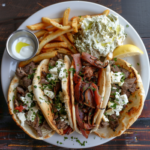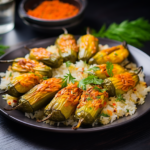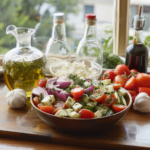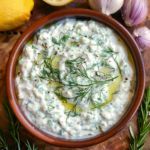
Greek Easter is a time of joy and celebration, and no Greek Easter feast is complete without an array of delicious traditional dishes. From succulent roasted lamb to flaky spinach pies and sweet Easter bread, traditional Greek Easter recipes are rich in flavor and steeped in centuries-old culinary traditions.
Some of the must-try traditional Greek Easter dishes include:
- Easter Lamb (Magiritsa): A fragrant and hearty soup made from lamb offal and wild greens, traditionally enjoyed after the midnight church service.
- Tsoureki (Greek Easter Bread): A sweet and aromatic braided bread enriched with flavors of orange zest and ground mahlab, often decorated with red-dyed eggs.
- Souvlaki: Skewered and grilled meat, usually marinated in herbs and served with pita bread, tzatziki, and a fresh salad.
- Spanakopita (Spinach Pie): A savory pie made with layers of crispy phyllo pastry and a filling of sautéed spinach, feta cheese, and aromatic herbs.
- Kokoretsi: A unique and traditional dish made from lamb or goat offal, wrapped in intestines and grilled until tender and flavorful.
In addition to the traditional recipes, modern Greek Easter dishes with a twist have gained popularity, offering a fusion of traditional flavors with contemporary techniques. Some examples include grilled lamb chops with lemon and herbs, stuffed tomatoes with feta and herbs, shrimp saganaki, Greek Easter salad, and even a decadent baklava cheesecake.
For those following vegetarian or vegan diets, there are also delicious options available. Vegan stuffed grape leaves, lentil moussaka, vegan spanakopita, and a refreshing vegan Greek salad are just a few examples of the delightful vegetarian and vegan Greek Easter recipes available.
Whether you prefer the traditional classics, modern variations, or vegetarian and vegan options, the diverse and flavorful Greek Easter recipes are sure to delight your taste buds and bring a taste of Greece to your Easter celebrations.
Key takeaways:
- Traditional Greek Easter dishes include Easter Lamb, Tsoureki, Souvlaki, Spanakopita, and Kokoretsi.
- Modern Greek Easter recipes put a twist on traditional dishes, such as Grilled Lamb Chops with Lemon and Herbs, Stuffed Tomatoes with Feta and Herbs, Shrimp Saganaki, Greek Easter Salad, and Baklava Cheesecake.
- For those following a vegetarian or vegan diet, there are options like Vegan Stuffed Grape Leaves, Lentil Moussaka, Vegan Spanakopita, and Vegan Greek Salad for delicious Greek Easter recipes.
Traditional Greek Easter Dishes

Photo Credits: Cookingwithgreekpeople.Com by Ralph Davis
Indulge in the rich flavors and vibrant traditions of Greek Easter as we explore the delightful world of traditional Greek Easter dishes. From succulent Easter Lamb to the sweet aroma of Tsoureki and the sizzling perfection of Souvlaki, this section will whisk you away to the culinary delights of Greece. Prepare to feast your senses on delectable Spanakopita and discover the unique flavors of Kokoretsi. Get ready to explore the mouthwatering dishes that make Greek Easter a truly unforgettable gastronomic experience.
Easter Lamb
The main dish for Greek Easter is the Easter Lamb, which holds significant cultural and religious importance. Here is a
highlighting the traditional Greek Easter Lamb and its significance:
| Dish | Details |
| Easter Lamb | Roasted whole lamb, seasoned with herbs and spices and cooked to perfection. |
Symbolizing the sacrifice of Jesus Christ, the Easter Lamb is typically prepared on a spit, slowly roasted until tender and juicy. It is the centerpiece of the Easter feast and is accompanied by various traditional Greek side dishes and desserts. This ancient tradition has been passed down through generations in Greece and is cherished as a symbol of rebirth and renewal during the Easter season.
Tsoureki
Tsoureki, a traditional Greek Easter sweet bread, is a must-have during the Pascha celebration. It is a braided bread made with a rich dough infused with aromatic spices like mahlab and mastiha. The bread is often adorned with colorful sprinkles or a red egg on top, symbolizing the resurrection of Christ. Tsoureki is enjoyed as a breakfast treat or dessert and is often accompanied by a cup of Greek coffee or tea. It is a delicious and symbolic part of Greek Easter traditions.
Souvlaki
Souvlaki is a popular Greek dish consisting of grilled skewered meat, typically pork or chicken, served with pita bread and various toppings. It is a versatile and delicious option for both casual meals and special occasions. Here is some information about souvlaki:
| Souvlaki | |
|---|---|
| Origin | Greek |
| Ingredients | Skewered meat (pork or chicken), pita bread, various toppings |
| Preparation | Meat is marinated in a mixture of olive oil, lemon juice, garlic, and herbs, then grilled to perfection. It is typically served with pita bread, tzatziki sauce, tomatoes, onions, and sometimes fries. |
| Variations | Souvlaki can also be made with beef, lamb, or vegetables for vegetarian options. |
| Popular Pairings | Greek salad, roasted potatoes, or a side of rice |
| Key Features | Juicy and flavorful meat, crispy pita bread, refreshing toppings |
| Keyword | souvlaki |
Enjoy the delicious flavors of souvlaki and experience a taste of Greece!
Spanakopita
Spanakopita is a traditional Greek dish made with phyllo dough and filled with spinach and feta cheese. It is a popular appetizer or main course during Easter celebrations in Greece. The dish is prepared by sautéing spinach with onions and garlic, then mixing it with crumbled feta cheese, eggs, and herbs. The mixture is then layered between sheets of phyllo dough, brushed with olive oil, and baked until golden and crispy. Spanakopita is a flavorful and nutritious dish that can be enjoyed by both vegetarians and non-vegetarians. Serve it warm as an appetizer or as a main course with a side of Greek salad.
Kokoretsi
Kokoretsi is a traditional Greek Easter dish made from lamb offal wrapped in intestines and slow-roasted on a spit. It is a delicacy enjoyed during the Pascha celebration and is often served alongside other Greek Easter foods like roast lamb and dyed Greek Easter eggs. The rich flavors of kokoretsi come from the combination of marinated olives, olive oil, and herbs used during the cooking process.
Suggestions for serving kokoretsi include pairing it with a side of lemon potatoes and a fresh Greek salad. For a modern twist, try incorporating kokoretsi into a sandwich or wrap with tzatziki sauce and fresh vegetables. The unique flavors and textures of kokoretsi make it a must-try dish during Greek Easter festivities.
Modern Greek Easter Recipes with a Twist
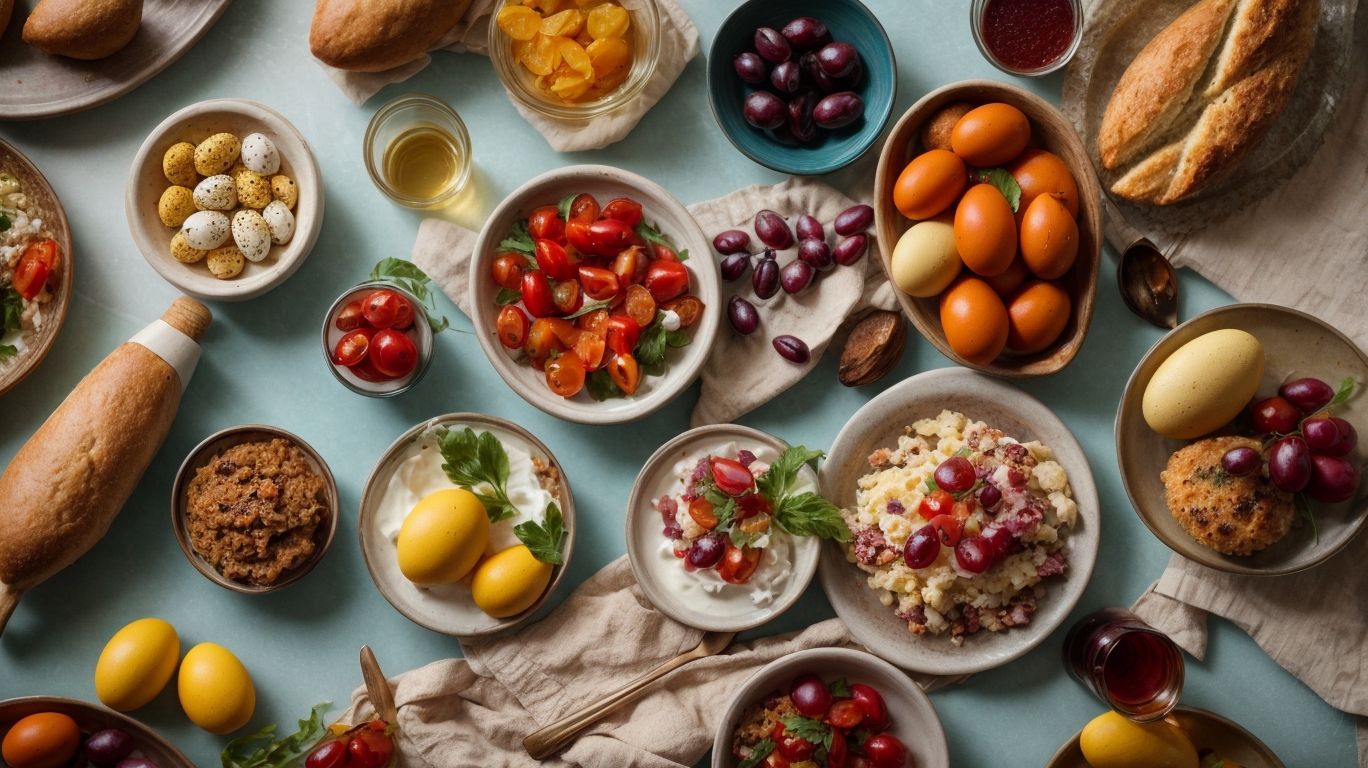
Photo Credits: Cookingwithgreekpeople.Com by Patrick Adams
Looking to put a modern spin on traditional Greek Easter recipes? Look no further, as we dive into mouthwatering creations that will tantalize your taste buds. Get ready to savor Grilled Lamb Chops with zesty Lemon and Herbs, indulge in Stuffed Tomatoes bursting with tangy Feta and Herbs, and experience the succulent flavors of Shrimp Saganaki. Pair your meal with a refreshing Greek Easter Salad, and top it all off with a delectable twist on a classic dessert – Baklava Cheesecake. Get ready to embark on a culinary adventure like no other!
Grilled Lamb Chops with Lemon and Herbs
Grilled Lamb Chops with Lemon and Herbs make a mouthwatering and flavorful dish that is perfect for Greek Easter or any special occasion. Follow these simple steps to prepare this delicious meal:
- Begin by preheating the grill to medium-high heat.
- In a small bowl, combine fresh lemon juice, minced garlic, chopped fresh herbs like rosemary, thyme, and oregano, along with some salt and black pepper.
- Next, generously brush the lamb chops with the delightful lemon and herb mixture, allowing them to marinate for at least 30 minutes.
- Grill the lamb chops for approximately 4-5 minutes on each side, or until they reach your desired level of doneness.
- Once cooked, carefully remove the succulent lamb chops from the grill and allow them to rest for a few minutes before serving.
- To enhance the presentation, garnish the dish with a sprinkle of fresh herbs and serve alongside roasted potatoes or a refreshing Greek salad.
Allow me to share a true story: Last Easter, we gathered as a family in our backyard to celebrate Greek Easter. The star of the meal was undeniably the flavorful and succulent Grilled Lamb Chops with Lemon and Herbs. The combination of juicy chops and the vibrant freshness of the lemon and herbs were an absolute delight to our taste buds. This memorable and special meal brought us closer together, reminding us of the cherished traditions associated with Greek Easter.
Stuffed Tomatoes with Feta and Herbs
Stuffed Tomatoes with Feta and Herbs is a delicious Greek Easter dish. It is made by hollowing out ripe tomatoes and filling them with a mixture of feta cheese, herbs like dill and parsley, and breadcrumbs. The tomatoes are then baked until tender and the filling is melted and golden. This dish is often served as a side or appetizer during Easter celebrations in Greece. The combination of juicy tomatoes, creamy feta cheese, and fragrant herbs creates a burst of flavors that is truly delightful. Stuffed Tomatoes with Feta and Herbs make a colorful and flavorful addition to any Greek Easter meal. Fact: Feta cheese is a popular ingredient in Greek cuisine and is traditionally made from sheep’s milk.
Shrimp Saganaki
Shrimp Saganaki is a delicious Greek dish that combines succulent shrimp with a rich tomato-based sauce and melted cheese. It is a popular choice for seafood lovers and can be served as an appetizer or main course. The dish is typically made by sautéing the shrimp with garlic, onions, and herbs, then simmering them in a tomato sauce until cooked through. Feta cheese is added to the sauce and baked until melted and bubbly. Shrimp Saganaki is a flavorful and comforting dish that showcases the unique flavors of Greek cuisine.
Greek Easter Salad
Greek Easter Salad is a refreshing and vibrant dish that complements the rich flavors of traditional Greek Easter recipes. Incorporating fresh vegetables and zesty flavors, this salad adds a lighter element to the Easter meal. Here is a list of key ingredients and elements to consider when making:
| Key Ingredients: |
|---|
| Fresh vegetables: Include crisp lettuce, juicy tomatoes, cucumbers, and colorful bell peppers. |
| Olives and feta cheese: These traditional Greek ingredients add a salty and tangy flavor to the salad. |
| Herbs and seasonings: Enhance the taste with chopped fresh dill, mint, and oregano. Dress the salad with olive oil and lemon juice. |
| Easter touches: For a festive twist, garnish the salad with red Greek Easter eggs or incorporate the colors of the Greek flag (blue and white). |
Greek Easter Salad not only provides a healthy and refreshing addition to the table but also adds a touch of Greek tradition to the Easter celebration.
Baklava Cheesecake
| Baklava Cheesecake | Baklava Cheesecake is a delicious fusion of two beloved desserts, combining the rich flavors of baklava with the creamy texture of cheesecake. |
| Ingredients | Phyllo dough, walnuts, cream cheese, sugar, butter, honey, cinnamon |
| Preparation | Layer phyllo dough in a baking dish, alternating with a mixture of walnuts, sugar, and cinnamon. In a separate bowl, mix cream cheese, sugar, and eggs. Pour cream cheese mixture over the phyllo layers. Bake until golden brown and let it cool. Drizzle honey on top. |
| Serving | Serve chilled, garnished with crushed walnuts and a drizzle of honey. Enjoy this decadent dessert with a cup of Greek coffee or a glass of sweet wine. |
Vegetarian and Vegan Greek Easter Recipes
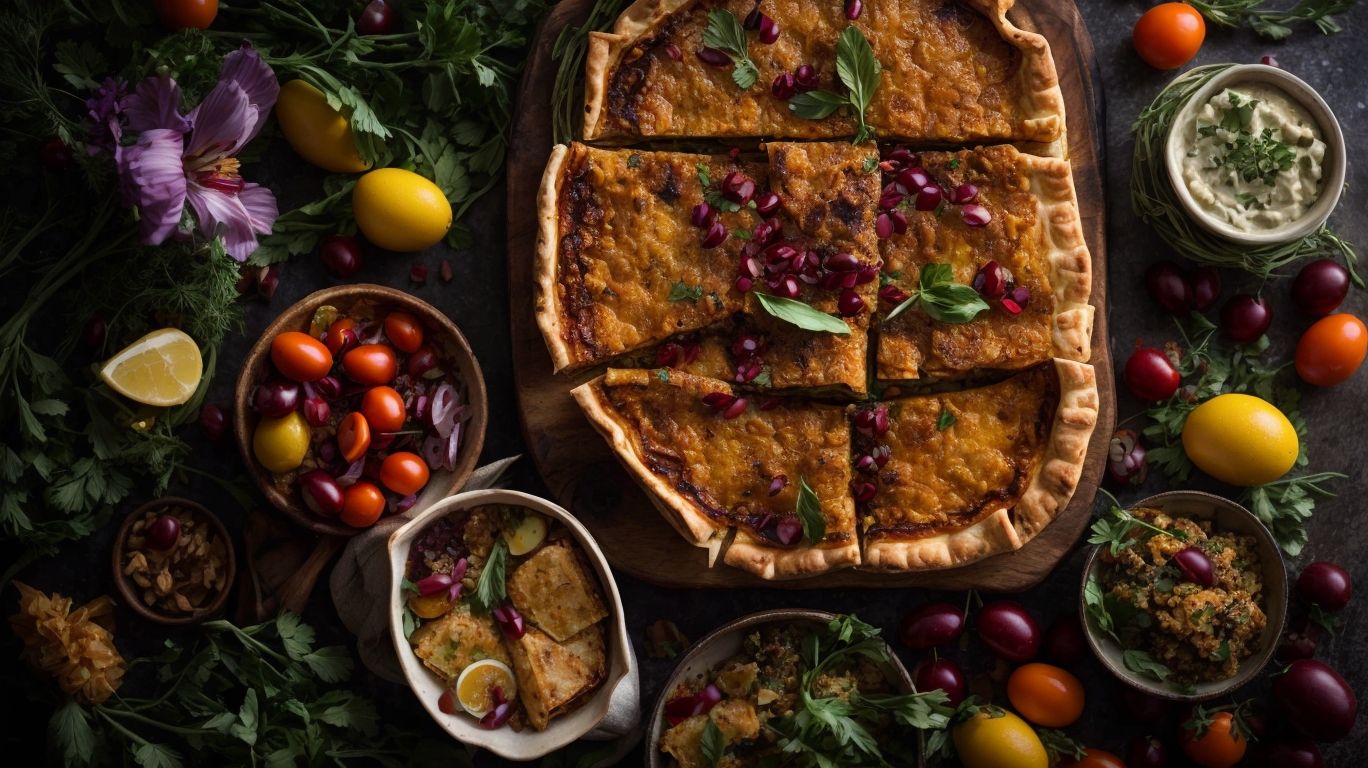
Photo Credits: Cookingwithgreekpeople.Com by Ronald Garcia
Looking to add a vegetarian or vegan twist to your Greek Easter celebration? Join us as we dive into the world of tantalizing vegetarian and vegan Greek Easter recipes. From the delectable Vegan Stuffed Grape Leaves and mouthwatering Lentil Moussaka, to the savory Vegan Spanakopita and refreshing Vegan Greek Salad, these recipes are sure to impress even the most discerning palates. Get ready to embark on a culinary journey that celebrates tradition with a plant-based twist.
Vegan Stuffed Grape Leaves
A Flavorful and Nutritious Dish
Vegan stuffed grape leaves are a flavorful and nutritious dish that is perfect for those following a plant-based diet. Made with tender grape leaves filled with a mixture of rice, herbs, and spices, these stuffed grape leaves are a popular Mediterranean delicacy.
They can be served as an appetizer or as a main course and are often enjoyed during Greek Easter celebrations. The grape leaves are carefully rolled and cooked until tender, resulting in a delicious and satisfying dish that is both vegan and gluten-free.
For more Greek Easter recipes, check out Greek Easter Recipes from a reputed source.
Give this vegan twist on a traditional Greek dish a try and impress your guests with its vibrant flavors!
Lentil Moussaka
Lentil Moussaka is a delicious and healthy vegetarian twist on the traditional Greek dish. It consists of layers of lentils, eggplant, and potatoes, topped with a creamy bechamel sauce.
Here’s a table showcasing the key ingredients and steps to make:
| Ingredients | Preparation |
|---|---|
| Lentils | Cook until tender |
| Eggplant | Slice and roast in the oven |
| Potatoes | Slice and parboil |
| Bechamel sauce | Prepare a creamy sauce with flour, butter, and milk |
Assemble the moussaka by layering the ingredients and bake in the oven until golden and bubbly. Serve hot and enjoy this flavorful and nutritious Greek dish!
Suggestions:
- Experiment with different spices and herbs to add more flavor to the lentil filling.
- Serve the moussaka with a side salad or some tzatziki sauce for a complete meal.
- Consider adding some crumbled feta cheese on top for a tangy twist.
Vegan Spanakopita
Spanakopita is a delicious Greek dish made with layers of crispy phyllo dough and a flavorful spinach filling. It is a perfect option for those following a vegan diet or looking for a healthier alternative. Instead of using feta cheese, this recipe uses a combination of tofu and nutritional yeast to achieve a creamy and cheesy texture. The spinach filling is seasoned with herbs and spices such as dill, garlic, and lemon juice, giving it a refreshing and tangy flavor. Vegan Spanakopita is a crowd-pleasing appetizer or main dish option that everyone can enjoy, regardless of dietary restrictions.
Fact: Spanakopita is also known as “spinach pie” and is a popular dish in Greek cuisine.
Vegan Greek Salad
A Vegan Greek Salad is a refreshing and flavorful dish that can be enjoyed by everyone. It is packed with fresh vegetables and tangy dressing, making it a healthy and delicious option. Here is a breakdown of the ingredients used in a Vegan Greek Salad:
| Ingredient | Importance |
|---|---|
| Fresh vegetables | Essential for the salad base |
| Olives | Adds a briny flavor |
| Cucumbers | Provides a refreshing crunch |
| Tomatoes | Adds juiciness to the salad |
| Red onions | Adds a mild sharpness |
| Vegan feta cheese | Provides a creamy element |
| Olive oil | Adds richness to the dressing |
| Lemon juice | Brings a citrusy tang |
| Dried oregano | Offers an herbal note |
The Vegan Greek Salad is a versatile dish that can be enjoyed as a light meal or as a side dish. It is perfect for those following a vegan lifestyle or anyone looking for a healthy and flavorful option.
Some Facts About Greek Easter Recipes:
- ✅ Greek Easter is a popular holiday in Greece, even bigger than Christmas. (Source: Our Team)
- ✅ Traditional Greek Easter recipes are being shared to help people celebrate the holiday. (Source: Our Team)
- ✅ Tsoureki is a popular Greek sweet bread that resembles brioche. (Source: Our Team)
- ✅ Koulourakia are fluffy and crunchy Greek Easter cookies that are quick to bake. (Source: Our Team)
- ✅ Lazarakia are easy and aromatic breads made for Easter. (Source: Our Team)
Frequently Asked Questions
What is a traditional Greek Easter recipe?
A traditional Greek Easter recipe is the Easter Lamb Soup, made with the head and innards of the lamb, or adapted using chicken and canned chicken stock. It is finished with an egg-lemon mixture.
How do I make Greek Easter cheese dishes?
To make traditional Greek Easter cheese dishes, use fresh spring cheeses made with the first spring milk. Saffron biscuits are a popular use for these cheeses.
What are some recommended wines to pair with the Greek Easter feast?
Recommended wines to pair with the Greek Easter feast are fruity wines from the Mantinia region, such as Tselepos or Biblia Chora, or a fruity retsina like Ritinitis Nobilis by Gaia.
What are some traditional Greek Easter side dishes?
Traditional Greek Easter side dishes include a mixed green salad from Lesbos, featuring fresh greens and herbs, and a Leg of Lamb Stuffed with Greens and Feta, made with various spring wild greens, fennel, mint, and fresh cheese.
What are some traditional Greek Easter desserts?
Traditional Greek Easter desserts include Tsoureki muffins, Koulourakia cookies, Lazarakia bread, Baklava, and Walnut Strudel.
How can I make traditional Greek Easter bread?
To make traditional Greek Easter bread, known as Tsoureki, you can follow a recipe that includes braided Koulourakia and aromatic Tsoureki dough. The bread is often decorated with shiny Easter eggs.
Embark on a Culinary Odyssey with Chef on a Bike
Unveiling the Heart and Soul of Greek Gastronomy, Sponsored by Digital Heroes Caffe and Financial Navagator 360
Welcome to Chef on a Bike, your haven for exploring the rich culinary tapestry of Greece. Our platform blooms as a vibrant community where the zest for Greek culinary traditions finds its home. As you venture into our culinary abode, you’re embraced by the love for hearty Greek meals, the tantalizing aroma of fresh herbs, and the camaraderie that’s synonymous with sharing a meal. Our mission is eloquent in its simplicity yet resonates profoundly; forging a nexus between the novice and seasoned cook, intertwining age-old traditions with fresh culinary narratives, and creating a sanctuary where every Greek cuisine aficionado finds solace in the comforting arms of a Greek kitchen.
Our digital hearth is a treasure trove of authentic recipes, discerning articles, and interactive cooking sessions meticulously curated and conducted by passionate Greek chefs. Their expertise carries the essence of Greek cuisine in every stir, every chop, and every simmer. Begin your journey with our inviting Greek Mezes Recipe, each recipe here is not just a guide to creating a meal but an odyssey into the heart of Greek culinary traditions.
Culinary Repositories for Your Hellenic Gastronomic Journey:
- My Greek Dish – Delve into a rich collection of traditional Greek recipes.
- The Mediterranean Dish – Embark on a journey through Greek and Mediterranean culinary wonders.
- The Greek Foodie – Explore a vibrant palette of Greek culinary delights.
- RecipeTin Eats – Traverse through global cuisines with a special focus on Greek delicacies.
- Vicki’s Greek Recipes – Home-cooked Greek recipes shared with love.
- Lemon Blossoms – A blend of international recipes with a Greek-inspired section.
- Souvlaki For The Soul – Modern interpretations of classic Greek recipes.
- My Sweet Greek – An odyssey into the sweet and savory traditions of Greek culinary arts.
- Olive Tomato – Wholesome Greek and Mediterranean recipes for modern kitchens.
- Akis Petretzikis – The official platform of Greek chef Akis Petretzikis, offering a diverse range of Greek recipes.
Supported by Digital Heroes Caffe and Financial Navagator 360, our initiative breaks geographical barriers, inviting every kitchen to morph into a quaint Greek taverna, resonating with the symphony of flavors, aromas, and the timeless charm of Hellenic hospitality. Join us in celebrating the enduring legacy of Greek gastronomy, and let each recipe be a passage into the heart of Greece’s culinary tradition. Welcome to Chef on a Bike, where every meal is a heartfelt celebration of life, tradition, and shared culinary endeavors.










